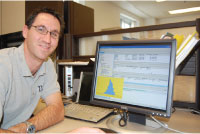 New scheduling software developed by MIRARCO Mining Innovation, a not-for profit research organization based at Laurentian University in Sudbury, promises to dramatically change the way schedules are produced for mine development.
New scheduling software developed by MIRARCO Mining Innovation, a not-for profit research organization based at Laurentian University in Sudbury, promises to dramatically change the way schedules are produced for mine development.
The Schedule Optimization Tool (SOT) works with Gijima AST’s Enhanced Production Scheduler to produce multiple scheduling scenarios in hours.
Using traditional methods, mine planners could take "a couple of weeks or months to finish a schedule, " said Bryan Maybee, a MIRARCO research associate who worked on the project. "I’ve heard stories of it taking as long as three months."
And that’s "just to get feasibility, not optimality," noted Lorrie Fava, a research scientist who began working on SOT four years ago. "With SOT, we get every schedule generated that’s feasible in a couple of minutes and we’re driving to something that’s more optimal."
Using SOT, mine planners are able to generate scheduling options that would never have occurred to them.
"By creating so many schedules, we now have the ability to look at something that might go against a planner’s conventional wisdom," said Maybee. Using traditional methods, a planner might come up with one, two or possibly three scenarios. The multiple options generated by SOT allows them to "try different directions through the mine that may not have been thought of due to rule of thumb or time constraints."
Shawn Wilson, a senior mining engineer with Barrick Gold’s Technical Services Group in Toronto, can vouch for SOT’s effectiveness.
"We took a base case schedule that a planning engineer had done, ran it through SOT as is and then we let SOT run on its own," he said. "The result was a 30 per cent improvement in net present value (NPV)."
The optimized schedule produced by SOT in Wilson’s test run was attributed to getting into some higher grade stopes earlier because " in the NPV world, increasing revenue and profits in the early years pays dividends."
SOT works with the mine design, ore grades, tonnage expectations, price projections, cost estimates and production constraints such as skipping capabilities, mill size and advance rates to produce and rank scheduling options.
"We hope it’s going to change the way mine planners go about doing their work," said Fava. "It will free them up from a lot of manual labour and allow them to use their skills for higher-level strategic decisions and review of the scenarios produced."
MIRARCO owns the intellectual property and will continue to maintain the code, but has partnered with Gigima AST to market SOT.
Barrick bought into the idea in 2004, recalled Wilson. "MIRARCO approached us with the idea and we thought is was something the industry could use." Since then, SOT has been absorbed by the much larger Planning and Rapid Integrated Mine Optimization (PRIMO) research project, which aims to integrate SOT and three other existing applications into a single mine planning and scheduling framework.
MIRARCO developers worked closely with mining engineers through the development of SOT and will continue to work with users and act on their feedback to broaden its scope.
"It needs to be client driven because we’re an applied research company," noted Fava, who has a PhD in Computer Science. "It has to be more than just academically interesting. It has to be something that’s useful in the real world. That’s how it has been driven since the beginning. We had mine planners working with us every step of the way."
According to Wilson, SOT will prove valuable in scoping and feasibility studies for new mine developments and as part of the general life of mine budgeting and planning process that an operating mine goes through every year.
One thing SOT won’t do is put mining engineers out of a job.
"SOT will never replace an engineer’s intuition to be able to mine logically," said Wilson. "It relies on the planning engineer’s input and can only find solutions within those constraints, but, as you introduce more activities, the number of different ways of mining increases dramatically, so you can quickly run different scenarios."
Engineers will still have to review and assess the scheduling scenarios generated by SOT, warned Wilson. "Using SOT doesn’t guarantee a good schedule. It’s like anything. If you put garbage in, you’re going to get garbage out."
According to Maybee, the optimization techniques developed for SOT provides MIRARCO with a platform from which additional automated decision support tools can be produced in the future.


